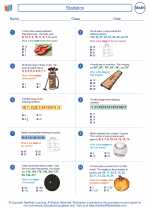Weather Stations Study Guide
A weather station is a facility, either on land or sea, with instruments and equipment for observing atmospheric conditions to provide information for weather forecasts and to study the weather and climate. Weather stations are essential for gathering data on temperature, humidity, wind speed and direction, barometric pressure, and other atmospheric variables.
Types of Weather Stations:
- Automated Weather Stations (AWS): These stations use sensors and electronic equipment to automatically collect and transmit weather data.
- Manned Weather Stations: These stations are operated and managed by personnel who manually record weather data at regular intervals.
- Meteorological Balloon Stations: These stations release weather balloons equipped with instruments to measure atmospheric conditions at various altitudes.
Key Instruments at Weather Stations:
- Thermometer: Measures temperature.
- Hygrometer: Measures humidity.
- Anemometer: Measures wind speed and direction.
- Barometer: Measures barometric pressure.
- Rain Gauge: Measures precipitation.
Importance of Weather Stations:
Weather stations play a crucial role in providing data for weather forecasts, monitoring severe weather events, studying climate trends, and supporting various industries such as agriculture, aviation, and marine transportation. They help in understanding and predicting weather patterns, which is essential for disaster preparedness and resource management.
Study Tips:
- Understand the function of each instrument at a weather station.
- Learn about the different types of weather stations and their operational methods.
- Explore the impact of weather stations on various sectors and their role in scientific research.
- Practice interpreting weather data and understanding its significance for local and global weather patterns.
[Weather Stations] Related Worksheets and Study Guides:
.◂Math Worksheets and Study Guides Sixth Grade. Statistics
Study Guide Statistics
Statistics  Worksheet/Answer key
Worksheet/Answer key Statistics
Statistics  Worksheet/Answer key
Worksheet/Answer key Statistics
Statistics  Worksheet/Answer key
Worksheet/Answer key Statistics
Statistics  Worksheet/Answer key
Worksheet/Answer key Statistics
Statistics  Worksheet/Answer key
Worksheet/Answer key Statistics
Statistics  Worksheet/Answer key
Worksheet/Answer key Statistics
Statistics 

 Worksheet/Answer key
Worksheet/Answer key
 Worksheet/Answer key
Worksheet/Answer key
 Worksheet/Answer key
Worksheet/Answer key
 Worksheet/Answer key
Worksheet/Answer key
 Worksheet/Answer key
Worksheet/Answer key
 Worksheet/Answer key
Worksheet/Answer key

The resources above cover the following skills:
Data Analysis and Probability (NCTM)
Select and use appropriate statistical methods to analyze data.
Find, use, and interpret measures of center and spread, including mean and interquartile range.